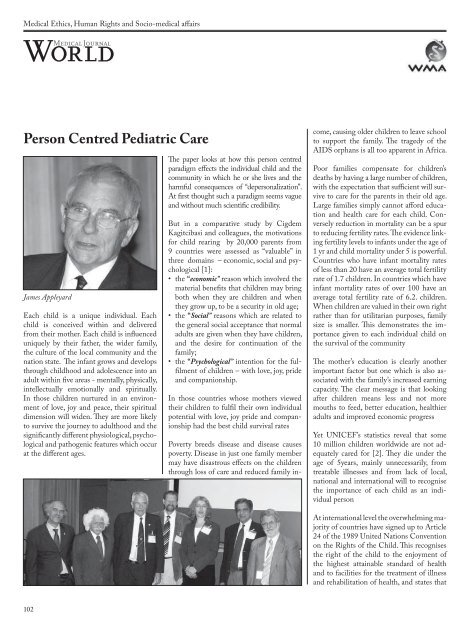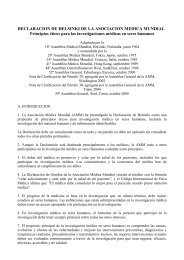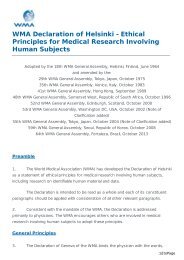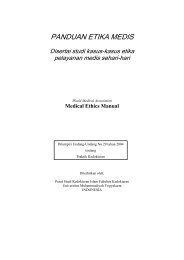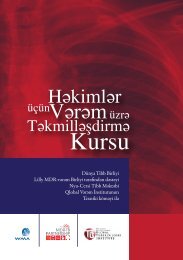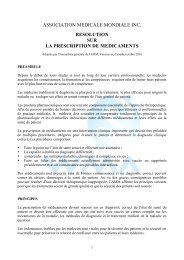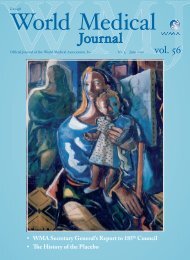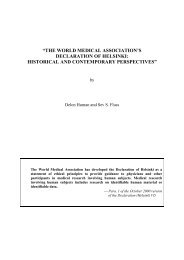wma 7-2.indd - World Medical Association
wma 7-2.indd - World Medical Association
wma 7-2.indd - World Medical Association
Create successful ePaper yourself
Turn your PDF publications into a flip-book with our unique Google optimized e-Paper software.
<strong>Medical</strong> Ethics, Human Rights and Socio-medical affairs<br />
Person Centred Pediatric Care<br />
James Appleyard<br />
Each child is a unique individual. Each<br />
child is conceived within and delivered<br />
from their mother. Each child is influenced<br />
uniquely by their father, the wider family,<br />
the culture of the local community and the<br />
nation state. The infant grows and develops<br />
through childhood and adolescence into an<br />
adult within five areas - mentally, physically,<br />
intellectually emotionally and spiritually.<br />
In those children nurtured in an environment<br />
of love, joy and peace, their spiritual<br />
dimension will widen. They are more likely<br />
to survive the journey to adulthood and the<br />
significantly different physiological, psychological<br />
and pathogenic features which occur<br />
at the different ages.<br />
The paper looks at how this person centred<br />
paradigm effects the individual child and the<br />
community in which he or she lives and the<br />
harmful consequences of “depersonalization”.<br />
At first thought such a paradigm seems vague<br />
and without much scientific credibility.<br />
But in a comparative study by Cigdem<br />
Kagitcibasi and colleagues, the motivations<br />
for child rearing by 20,000 parents from<br />
9 countries were assessed as “valuable” in<br />
three domains – economic, social and psychological<br />
[1]:<br />
• the “economic” reason which involved the<br />
material benefits that children may bring<br />
both when they are children and when<br />
they grow up, to be a security in old age;<br />
• the “Social” reasons which are related to<br />
the general social acceptance that normal<br />
adults are given when they have children,<br />
and the desire for continuation of the<br />
family;<br />
• the “Psychological” intention for the fulfilment<br />
of children – with love, joy, pride<br />
and companionship.<br />
In those countries whose mothers viewed<br />
their children to fulfil their own individual<br />
potential with love, joy pride and companionship<br />
had the best child survival rates<br />
Poverty breeds disease and disease causes<br />
poverty. Disease in just one family member<br />
may have disastrous effects on the children<br />
through loss of care and reduced family income,<br />
causing older children to leave school<br />
to support the family. The tragedy of the<br />
AIDS orphans is all too apparent in Africa.<br />
Poor families compensate for children’s<br />
deaths by having a large number of children,<br />
with the expectation that sufficient will survive<br />
to care for the parents in their old age.<br />
Large families simply cannot afford education<br />
and health care for each child. Conversely<br />
reduction in mortality can be a spur<br />
to reducing fertility rates. The evidence linking<br />
fertility levels to infants under the age of<br />
1 yr and child mortality under 5 is powerful.<br />
Countries who have infant mortality rates<br />
of less than 20 have an average total fertility<br />
rate of 1.7 children. In countries which have<br />
infant mortality rates of over 100 have an<br />
average total fertility rate of 6.2. children.<br />
When children are valued in their own right<br />
rather than for utilitarian purposes, family<br />
size is smaller. This demonstrates the importance<br />
given to each individual child on<br />
the survival of the community<br />
The mother’s education is clearly another<br />
important factor but one which is also associated<br />
with the family’s increased earning<br />
capacity. The clear message is that looking<br />
after children means less and not more<br />
mouths to feed, better education, healthier<br />
adults and improved economic progress<br />
Yet UNICEF’s statistics reveal that some<br />
10 million children worldwide are not adequately<br />
cared for [2]. They die under the<br />
age of 5years, mainly unnecessarily, from<br />
treatable illnesses and from lack of local,<br />
national and international will to recognise<br />
the importance of each child as an individual<br />
person<br />
At international level the overwhelming majority<br />
of countries have signed up to Article<br />
24 of the 1989 United Nations Convention<br />
on the Rights of the Child. This recognises<br />
the right of the child to the enjoyment of<br />
the highest attainable standard of health<br />
and to facilities for the treatment of illness<br />
and rehabilitation of health, and states that<br />
102


